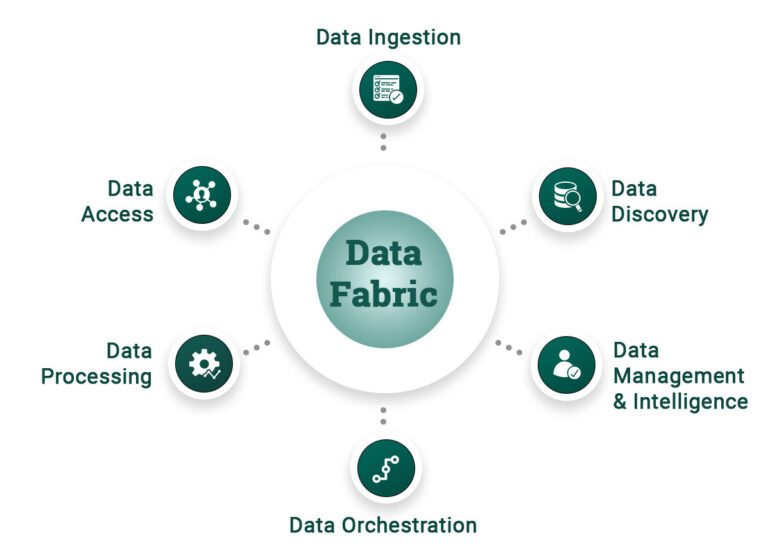TL;DR:
- Data fabric provides a holistic view of information assets, enabling organizations to leverage automation, AI, and ML effectively.
- Establishing a solid data-management foundation is crucial, considering factors like data architecture and a modern data stack.
- Key functions to prioritize: data ingestion, data storage, and data indexing and cataloging.
- Overcoming obstacles such as lack of engineering talent and ensuring business leaders’ investment in data and analytics.
- Adopting a lean and agile methodology for delivering data and analytics is essential.
- Implementing data sharing, customer applications, and open-source AI platforms and libraries unlocks the full potential of AI.
- Data fabric enables businesses to integrate and connect information, empowering strategic data management.
Main AI News:
In today’s fast-paced digital landscape, organizations are constantly seeking innovative ways to harness the full potential of artificial intelligence (AI). However, the adoption of AI has often been impeded by a common hurdle: the presence of unclear, unstructured, and unconnected data. Fortunately, there is a solution revolutionizing the way businesses approach data management – the construction of an integrated data fabric.
Data fabric offers organizations a comprehensive view of their information assets, allowing them to unlock the true power of technologies like automation, AI, and machine learning (ML). By connecting information from disparate sources, data fabric provides a unified and holistic perspective, enabling businesses to leverage these cutting-edge technologies more effectively.
Building a Solid Foundation for the Data Journey
To embark on a successful data journey, organizations must first establish a solid foundation for their data management practices. This begins by determining the most suitable data architecture through aligning on a data and analytics operating model. Factors such as decentralized versus centralized data management, mesh versus fabric data architecture, real-time integration, and identifying relevant use cases ahead of time must be carefully considered.
Furthermore, organizations should align themselves with a modern data stack that is adaptable and scalable to meet the ever-growing demands of the business and customers. This alignment ensures that priorities are driven by business and customer requirements, facilitating a dynamic and responsive approach to data management.
Key Functions to Consider
Within this data journey, there are three core functions that IT leaders should prioritize:
- Data Ingestion: Emphasize data-ingestion techniques that support batch, real-time, and event-driven formats. Leveraging technologies such as Kafka and share-storage gateways enables high-speed data ingestion, ensuring the timely availability of critical information for analysis and decision-making.
- Data Storage: Focus on establishing three layers of storage – RAW Storage, TRANSFORMED Storage, and CURATED Storage – to efficiently manage and store vast amounts of data. This layered approach enables organizations to achieve low-cost storage with exceptional reliability.
- Data Indexing and Cataloging: Properly indexing and cataloging data within the data lake ensures its visibility and searchability for data users. This enables quicker and more efficient data discovery and retrieval, streamlining business operations.
By addressing these crucial aspects in the early stages, organizations can avoid challenges that may arise during the implementation process, establishing a coherent and efficient approach to data management.
Deciphering the Data Puzzle
To gain a holistic view of data and maximize return on investment (ROI), organizations must overcome common missteps. One significant obstacle is the scarcity of strong engineering talent that possesses both technical skills and domain knowledge relevant to the industry. This expertise is vital for understanding the true potential value of data.
Additionally, organizations need to ensure that their business leaders are fully invested and excited about the transformative power of modern data and analytics. By investing in master data management and quality tools and techniques, enterprises enable a robust vision for 360-degree views of customers, products, and other key entities.
Collaboration across IT, operations, and business groups is also critical. Breaking down boundaries and fostering collaboration among data-product owners and domain experts leads to a more fruitful realization of the true business value that data can offer.
Adopting a Lean and Agile Methodology
The adoption of a lean and agile methodology is paramount for delivering data and analytics effectively. Demonstrating progress at each stage of the data journey is essential, as complex technical jargon and lengthy implementation cycles can lead to confusion, delays, and a loss of expected value. Taking a smarter approach allows organizations to deliver tangible results and keep pace with the rapidly evolving business landscape.
Implementing Data Learnings
Once a solid data foundation is in place, organizations can fully leverage AI and other technologies to transform data into actionable insights and drive new programs. Some notable technologies and use cases include:
- Data Sharing: Prioritize both internal and external data sharing to unlock new possibilities for collaboration, innovation, and value creation across the entire organization.
- Customer Applications: Seamlessly integrate external APIs embedding AI and analytics solutions into customer-facing applications. This enhances user experiences and improves overall customer satisfaction.
- Open-Source AI Platforms and Libraries: Explore the vast opportunities provided by workplace 2.0 capabilities, such as automated productivity and data discoverability. Leveraging open-source AI platforms and libraries allows organizations to build upon existing foundations and unleash their full potential.
Embracing the Power of Data Fabric
To remain competitive and harness the true power of AI, organizations must address the challenge of unclear, unstructured, and unconnected data. Implementing a data-fabric approach enables businesses to integrate and connect information from various sources, providing a holistic view of their assets. This comprehensive perspective informs a strategic approach to data management, empowering organizations to unlock new insights, enhance decision-making, and drive transformative growth.
Conclusion:
The adoption of data fabric and the effective utilization of AI technologies have transformative implications for the market. Organizations that embrace data fabric gain a competitive advantage by leveraging automation, AI, and ML to extract actionable insights from their information assets. By establishing a solid data-management foundation and embracing a lean and agile methodology, businesses can unlock the true potential of AI and drive innovation. This empowers them to make data-driven decisions, enhance customer experiences, and stay ahead in the rapidly evolving business landscape.

